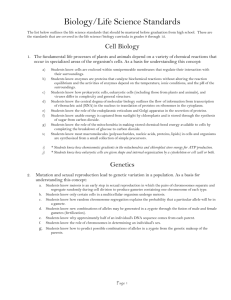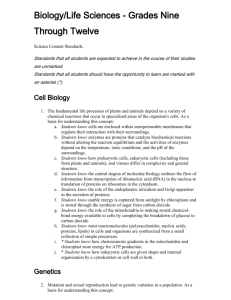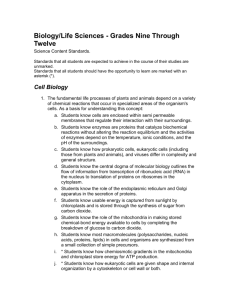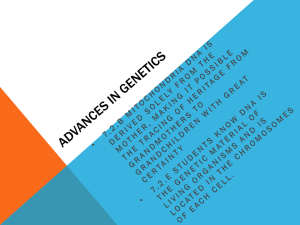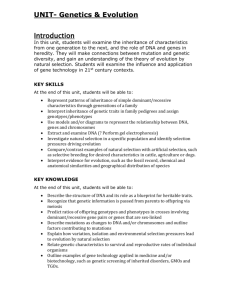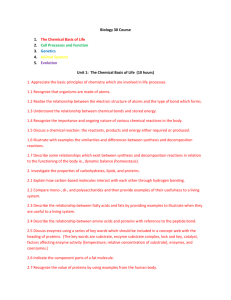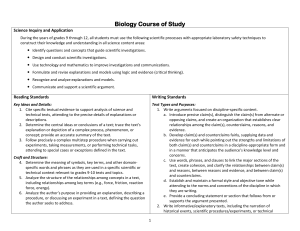Biology/Life Sciences
advertisement
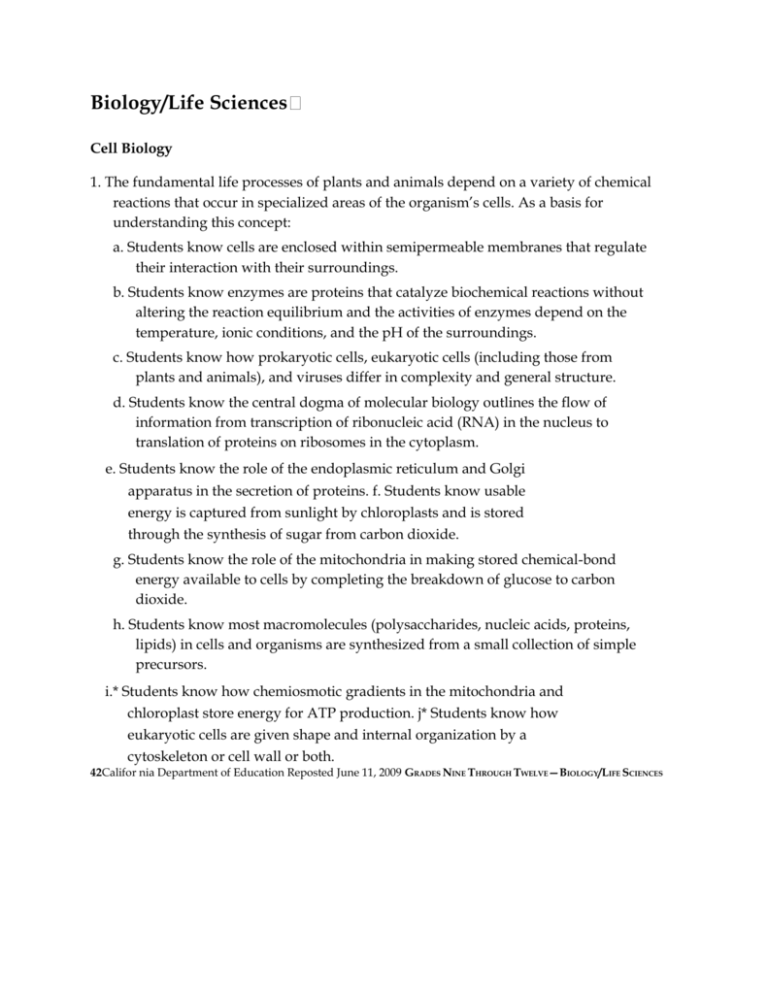
Biology/Life Sciences Cell Biology 1. The fundamental life processes of plants and animals depend on a variety of chemical reactions that occur in specialized areas of the organism’s cells. As a basis for understanding this concept: a. Students know cells are enclosed within semipermeable membranes that regulate their interaction with their surroundings. b. Students know enzymes are proteins that catalyze biochemical reactions without altering the reaction equilibrium and the activities of enzymes depend on the temperature, ionic conditions, and the pH of the surroundings. c. Students know how prokaryotic cells, eukaryotic cells (including those from plants and animals), and viruses differ in complexity and general structure. d. Students know the central dogma of molecular biology outlines the flow of information from transcription of ribonucleic acid (RNA) in the nucleus to translation of proteins on ribosomes in the cytoplasm. e. Students know the role of the endoplasmic reticulum and Golgi apparatus in the secretion of proteins. f. Students know usable energy is captured from sunlight by chloroplasts and is stored through the synthesis of sugar from carbon dioxide. g. Students know the role of the mitochondria in making stored chemical-bond energy available to cells by completing the breakdown of glucose to carbon dioxide. h. Students know most macromolecules (polysaccharides, nucleic acids, proteins, lipids) in cells and organisms are synthesized from a small collection of simple precursors. i.* Students know how chemiosmotic gradients in the mitochondria and chloroplast store energy for ATP production. j* Students know how eukaryotic cells are given shape and internal organization by a cytoskeleton or cell wall or both. 42Califor nia Department of Education Reposted June 11, 2009 GRADES NINE THROUGH TWELVE—BIOLOGY/LIFE SCIENCES Genetics 2. Mutation and sexual reproduction lead to genetic variation in a population. As a basis for understanding this concept: a. Students know meiosis is an early step in sexual reproduction in which the pairs of chromosomes separate and segregate randomly during cell division to produce gametes containing one chromosome of each type. b. Students know only certain cells in a multicellular organism undergo meiosis. c. Students know how random chromosome segregation explains the probability that a particular allele will be in a gamete. d. Students know new combinations of alleles may be generated in a zygote through the fusion of male and female gametes (fertilization). e. Students know why approximately half of an individual’s DNA sequence comes from each parent. f. Students know the role of chromosomes in determining an individual’s sex. g. Students know how to predict possible combinations of alleles in a zygote from the genetic makeup of the parents. 3. A multicellular organism develops from a single zygote, and its phenotype depends on its genotype, which is established at fertilization. As a basis for understanding this concept: a. Students know how to predict the probable outcome of phenotypes in a genetic cross from the genotypes of the parents and mode of inheritance (autosomal or Xlinked, dominant or recessive). b. Students know the genetic basis for Mendel’s laws of segregation and independent assortment. c.* Students know how to predict the probable mode of inheritance from a pedigree diagram showing phenotypes. d.* Students know how to use data on frequency of recombination at meiosis to estimate genetic distances between loci and to interpret genetic maps of chromosomes. 4 3California Department of Education Reposted June 11, 20 09 GRADES NINE THROUGH TWELVE—BIOLOGY/LIFE SCIENCES 4. Genes are a set of instructions encoded in the DNA sequence of each organism that specify the sequence of amino acids in proteins characteristic of that organism. As a basis for understanding this concept: a. Students know the general pathway by which ribosomes synthesize proteins, using tRNAs to translate genetic information in mRNA. b. Students know how to apply the genetic coding rules to predict the sequence of amino acids from a sequence of codons in RNA. c. Students know how mutations in the DNA sequence of a gene may or may not affect the expression of the gene or the sequence of amino acids in an encoded protein. d. Students know specialization of cells in multicellular organisms is usually due to different patterns of gene expression rather than to differences of the genes themselves. e. Students know proteins can differ from one another in the number and sequence of amino acids. f.* Students know why proteins having different amino acid sequences typically have different shapes and chemical properties. 5. The genetic composition of cells can be altered by incorporation of exogenous DNA into the cells. As a basis for understanding this concept: a. Students know the general structures and functions of DNA, RNA, and protein. b. Students know how to apply base-pairing rules to explain precise copying of DNA during semiconservative replication and transcription of information from DNA into mRNA. c. Students know how genetic engineering (biotechnology) is used to produce novel biomedical and agricultural products. d.* Students know how basic DNA technology (restriction digestion by endonucleases, gel electrophoresis, ligation, and transformation) is used to construct recombinant DNA molecules. e.* Students know how exogenous DNA can be inserted into bacterial cells to alter their genetic makeup and support expression of new protein products. 44Califor nia Department of Education Reposted June 11, 2009 GRADES NINE THROUGH TWELVE—BIOLOGY/LIFE SCIENCES Ecology 6. Stability in an ecosystem is a balance between competing effects. As a basis for understanding this concept: a. Students know biodiversity is the sum total of different kinds of organisms and is affected by alterations of habitats. b. Students know how to analyze changes in an ecosystem resulting from changes in climate, human activity, introduction of nonnative species, or changes in population size. c. Students know how fluctuations in population size in an ecosystem are determined by the relative rates of birth, immigration, emigration, and death. d. Students know how water, carbon, and nitrogen cycle between abiotic resources and organic matter in the ecosystem and how oxygen cycles through photosynthesis and respiration. e. Students know a vital part of an ecosystem is the stability of its producers and decomposers. f. Students know at each link in a food web some energy is stored in newly made structures but much energy is dissipated into the environment as heat. This dissipation may be represented in an energy pyramid. g.* Students know how to distinguish between the accommodation of an individual organism to its environment and the gradual adaptation of a lineage of organisms through genetic change. Evolution 7. The frequency of an allele in a gene pool of a population depends on many factors and may be stable or unstable over time. As a basis for understanding this concept: a. Students know why natural selection acts on the phenotype rather than the genotype of an organism. b. Students know why alleles that are lethal in a homozygous individual may be carried in a heterozygote and thus maintained in a gene pool. c. Students know new mutations are constantly being generated in a gene pool. d. Students know variation within a species increases the likelihood that at least some members of a species will survive under changed environmental conditions. 4 5California Department of Education Reposted June 11, 20 09 GRADES NINE THROUGH TWELVE—BIOLOGY/LIFE SCIENCES e.* Students know the conditions for Hardy-Weinberg equilibrium in a population and why these conditions are not likely to appear in nature. f.* Students know how to solve the Hardy-Weinberg equation to predict the frequency of genotypes in a population, given the frequency of phenotypes. 8. Evolution is the result of genetic changes that occur in constantly changing environments. As a basis for understanding this concept: a. Students know how natural selection determines the differential survival of groups of organisms. b. Students know a great diversity of species increases the chance that at least some organisms survive major changes in the environment. c. Students know the effects of genetic drift on the diversity of organisms in a population. d. Students know reproductive or geographic isolation affects speciation. e. Students know how to analyze fossil evidence with regard to biological diversity, episodic speciation, and mass extinction. f.* Students know how to use comparative embryology, DNA or protein sequence comparisons, and other independent sources of data to create a branching diagram (cladogram) that shows probable evolutionary relationships. g.* Students know how several independent molecular clocks, calibrated against each other and combined with evidence from the fossil record, can help to estimate how long ago various groups of organisms diverged evolutionarily from one another. Physiology 9. As a result of the coordinated structures and functions of organ systems, the internal environment of the human body remains relatively stable (homeostatic) despite changes in the outside environment. As a basis for understanding this concept: a. Students know how the complementary activity of major body systems provides cells with oxygen and nutrients and removes toxic waste products such as carbon dioxide. b. Students know how the nervous system mediates communication between different parts of the body and the body’s interactions with the environment. 46Califor nia Department of Education Reposted June 11, 2009 GRADES NINE THROUGH TWELVE—BIOLOGY/LIFE SCIENCES c. Students know how feedback loops in the nervous and endocrine systems regulate conditions in the body. d. Students know the functions of the nervous system and the role of neurons in transmitting electrochemical impulses. e. Students know the roles of sensory neurons, interneurons, and motor neurons in sensation, thought, and response. f.* Students know the individual functions and sites of secretion of digestive enzymes (amylases, proteases, nucleases, lipases), stomach acid, and bile salts. g.* Students know the homeostatic role of the kidneys in the removal of nitrogenous wastes and the role of the liver in blood detoxification and glucose balance. h.* Students know the cellular and molecular basis of muscle contraction, including 2 the roles of actin, myosin, Ca , and ATP. i.* Students know how hormones (including digestive, reproductive, osmoregulatory) provide internal feedback mechanisms for homeostasis at the cellular level and in whole organisms. 10. Organisms have a variety of mechanisms to combat disease. As a basis for understanding the human immune response: a. Students know the role of the skin in providing nonspecific defenses against infection. b. Students know the role of antibodies in the body’s response to infection. c. Students know how vaccination protects an individual from infectious diseases. d. Students know there are important differences between bacteria and viruses with respect to their requirements for growth and replication, the body’s primary defenses against bacterial and viral infections, and effective treatments of these infections. e. Students know why an individual with a compromised immune system (for example, a person with AIDS) may be unable to fight off and survive infections by microorganisms that are usually benign. f.* Students know the roles of phagocytes, B-lymphocytes, and T-lymphocytes in the immune system. 4 7California Department of Education Reposted June 11, 20 09
